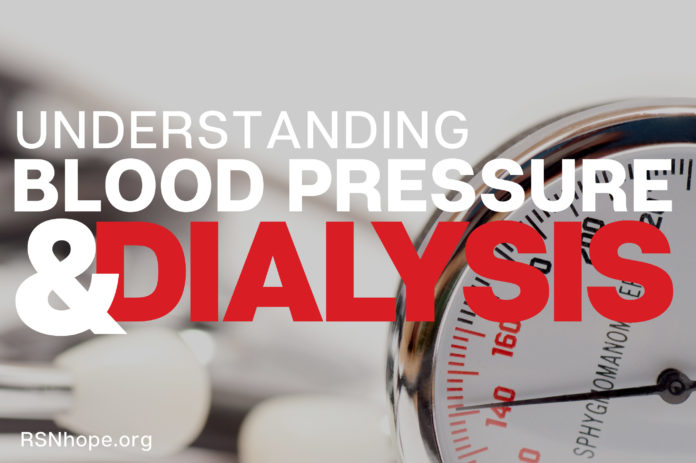What is Blood Pressure?
”Blood pressure” is the force of blood against your artery walls as it circulates through your body. Blood pressure (BP) normally rises and falls throughout the day. It can cause health problems if it stays too high for a long time or if it is too low to deliver enough oxygen to the organs.
Blood pressure is measured using two numbers. The first, systolic blood pressure, represents the “working” phase of your heart, or the pressure in your blood vessels when your heart contracts. The second, diastolic blood pressure, represents the pressure in your blood vessels when your heart “rests” between beats. Though individuals vary, generally a blood pressure before dialysis should be less than 150/90 and after treatment should be less than 130/80.
What happens when BP is too high?
Common dangers of high blood pressure are stroke, heart attack, and vessel diseases. High BP can cause congestive heart failure due to an increased load on the heart. Damage to vessel walls leads to atherosclerosis. In many dialysis patients, it is high blood pressure that prompted renal failure in the first place: the high force of blood pushed into very small vessels of the kidney causing scarring and thickening of those vessels and leading to permanent damage.
High blood pressure often has no warning signs or symptoms, so many people don’t realize they have it. Some symptoms may include headache, blurred vision, nervousness, sweating, difficulty sleeping or facial flushing. Even with no symptoms, hypertension needs ongoing treatment to protect the heart, kidneys and other organs from further damage.
What to watch out for with low blood pressure.
Blood pressure is checked in all medical settings, but it is even more significant for patients on dialysis. Low blood pressure, or hypotension, can create problems during dialysis. Know the symptoms so you can alert staff and get treatment quickly.
Common symptoms of low blood pressure can include dizziness, nausea, headaches, muscle cramps, and, in more severe cases, chest pain and loss of consciousness. Blood pressure may drop at any time during treatment. Often, the cause is a decrease in the volume of fluid in the bloodstream. Hypotension can occur even when your tissues are fluid overloaded!
What can you do to control blood pressure?
To minimize the risk of hypertension, control sodium, potassium, and other essential electrolytes the body uses to maintain fluid balance. The recommendation for patients with kidney disease: limit sodium intake to no more than 1,500 mg per day. Most sodium in today’s diet comes from processed foods and restaurants foods. Unhealthy lifestyles choices, such as smoking tobacco, obesity, and excessive alcohol consumption, may also contribute to hypertension.
To prevent hypotension during dialysis, take in adequate protein, as it helps fluid move from tissues into the bloodstream. The protein level is usually reflected as albumin in the lab. Patients are often encouraged to increase consumption of fish, eggs and chicken when albumin is low. Another important way to avoid hypotension is to keep fluid intake low between treatments so the change in body fluid isn’t so drastic. Removal of large amounts of fluid makes the treatment much harder on the heart. Weight gains between treatments should be no more than 5% of dry body weight.
Exercise can both improve high blood pressure and diminish hypotension during treatment. An exercise plan appropriate for a patient’s condition should be supervised by a physician to avoid injury.
Notes on medications:
Patients with cardiovascular conditions frequently require multiple blood pressure medications that work in different ways. One medication may increase urine output, another relaxes the blood vessels, and another improves heart rate, contractions or output. Some medications are available in combination, so patients may want to ask their doctor for options.
Blood pressure medications can affect dialysis. A doctor should advise patients when to take medications on dialysis versus non-dialysis days. If a patient takes BP medication at night, and then arrives at dialysis with very high blood pressure in the morning, either: 1) fluid gains are too high or 2) the evening dose is not adequate. This is dangerous. Patients’ checks of blood pressure at home morning and evening can help the doctor optimize timing and dosages.
The doctor may recommend postponing some medications before treatment on dialysis days, especially if a patient’s blood pressure falls during treatments. However, some medications protect the heart. Any alteration must be supervised by the doctor.
Ask your doctor or nurse if your blood pressure readings are at goal. If your high blood pressure is not well controlled or you experience low blood pressure during treatment, review the above with your doctor. Controlling blood pressure is key to lowering the risk of complications and achieving more comfortable treatment.
Learn more about controlling blood pressure:
Prevent or Slow the Progression of Kidney Disease from High Blood Pressure
References retrieved electronically on 3/23/2015
High Blood Pressure Educational Materials for Patients National Center for Chronic Disease Prevention and Health Promotion, Division for Heart Disease and Stroke Prevention
http://www.cdc.gov/dhdsp/data_statistics/fact_sheets/fs_bloodpressure.htm
Low Blood Pressure (Hypotension) During Dialysis Treatments By Dewayne Hasten, DPC Patient Ambassador, Hemodialysis Patient and Biomedical Engineer http://dpcedcenter.org/low-blood-pressure-hypotension
 About the Author
About the Author
Sandy is a Nurse Practitioner in Ventura County, Ca where she cares for patients on hemodialysis at several dialysis facilities. Practicing in nephrology for over 30 years, her background includes clinical and education experience in dialysis, as well as the management of earlier stages of kidney disease.
Web ID 984







